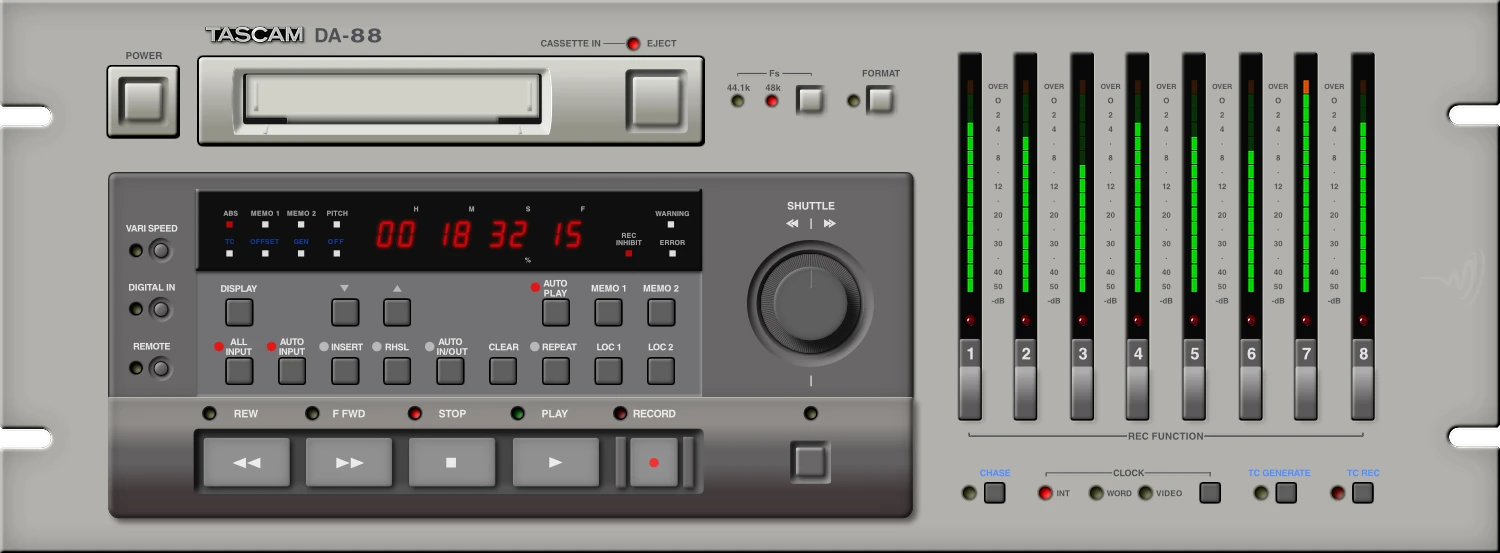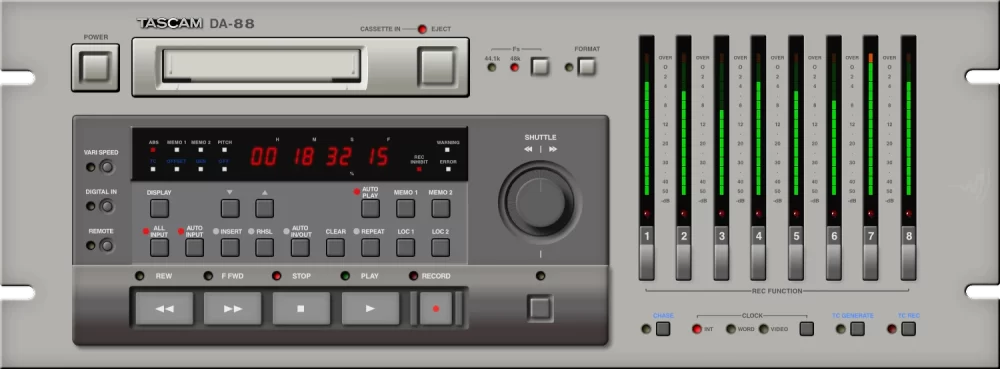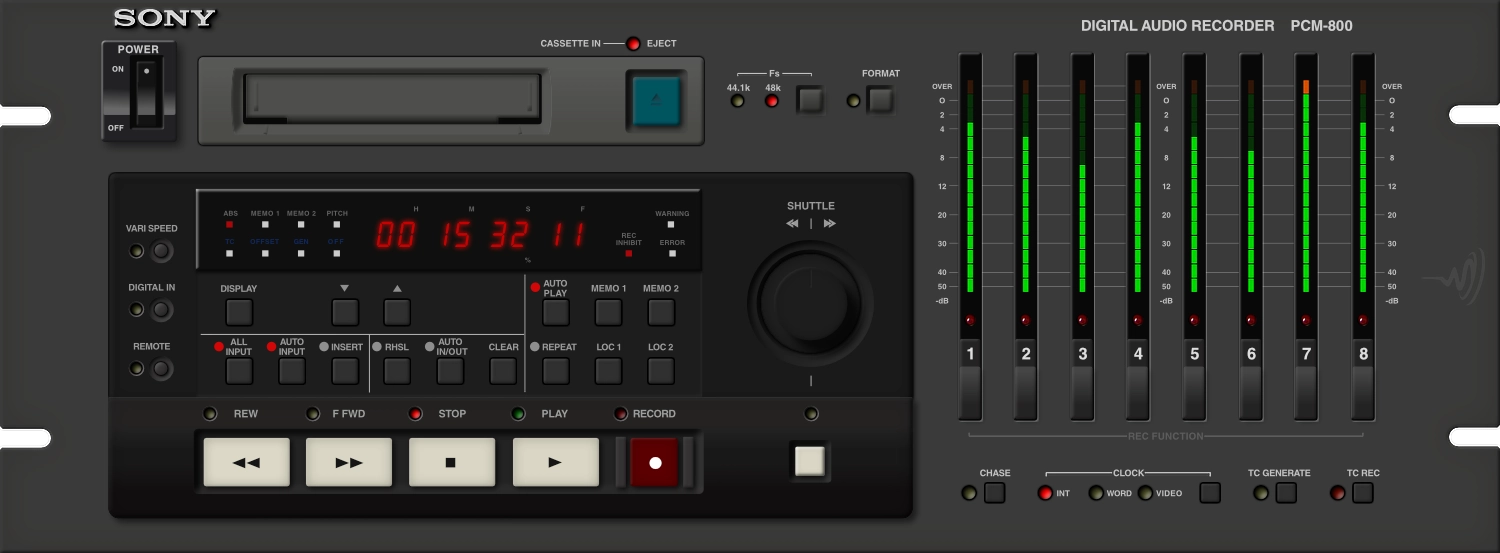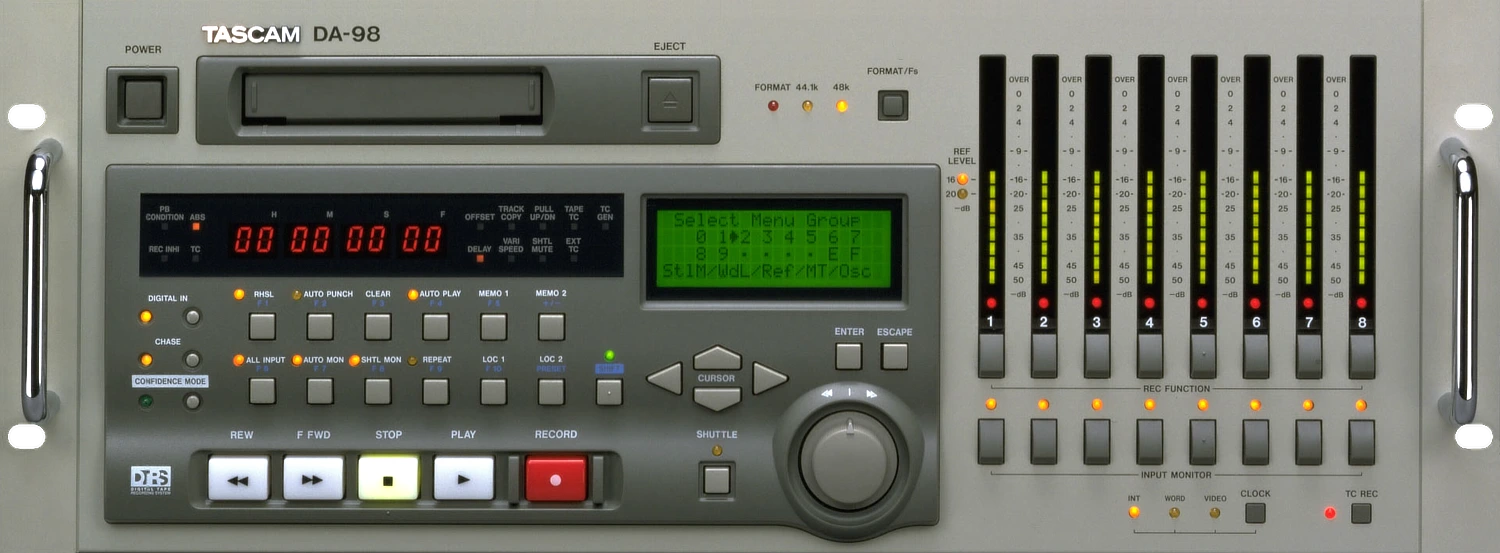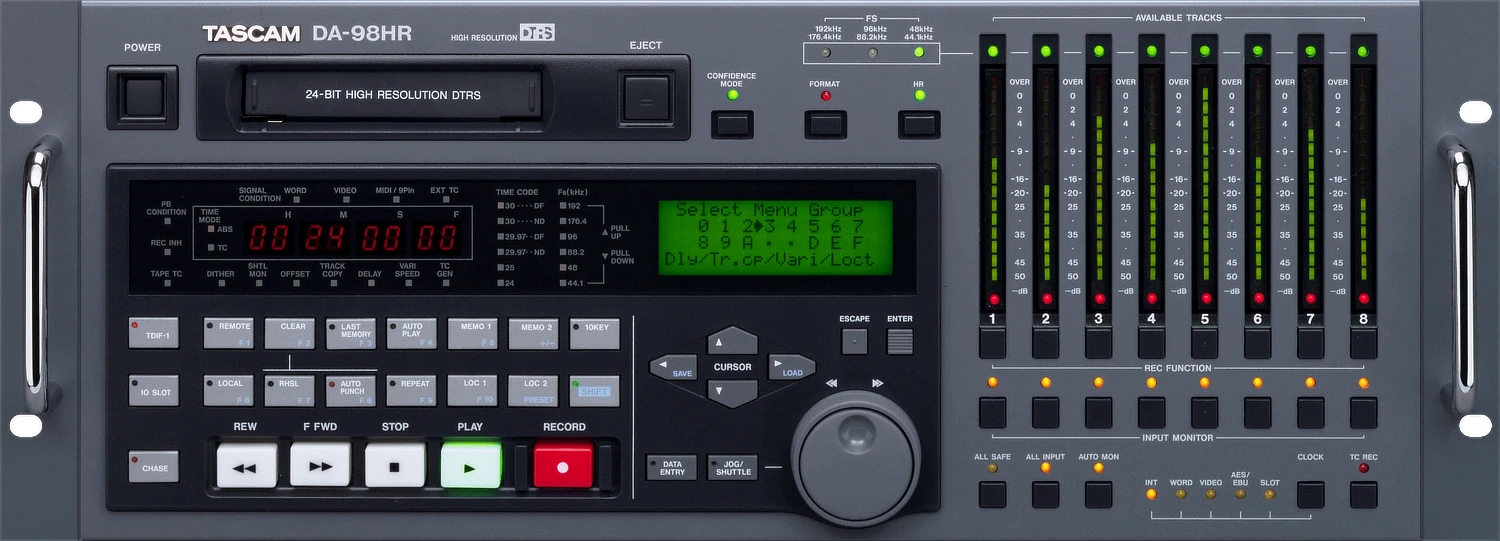Way back in 1993 and in the wake of the enormous success of the Alesis ADAT, TASCAM introduced the TASCAM DA-88 Modular Digital Multitrack Recorder to really take the challenge to Alesis. Where the Alesis ADAT used an S-VHS Cassette tape, the Tascam DA-88 used the far more compact Hi8 8mm cassette tapes, which were a superior metal tape formulation that provided higher density recording. A single tape could record for 108 minutes in the DTRS (Digital Tape Recording System) format.
TASCAM introduced a number of variants of the TASCAM DA-88 in the years that followed, as too did Sony with their PCM-800, and by 1999 TASCAM had sold over 60,000 units. At the time, it was TASCAM’s most successful product ever. A big part of the success was due to the reliability and durability of the DA-88 and the tape transport system it used. Like the Alesis ADAT, the Tascam DA-88 system could link multiple units together to form a larger recording system. In fact, it was possible to link up to 16 DA-88s to have 128 tracks of digital recording with lightening fast lock up between machines.
The TASCAM DA-88 machines were a 16 bit recording system with sampling rates of either 44.1kHz or 48kHz. Later machines such as the DA-98HR and TASCAM DA-78HR offered 24 bit recording. The TASCAM DA-78HR was still limited to 44.1kHz and 48kHz sampling rates, however the DA-98HR was also capable of recording at 88.2/96kHz over 4 tracks, or 176.4/192kHz over two tracks. From day one, the sound quality of the Tascam DA-88 system was superior to that of the Alesis ADAT system, however in time and with newer models the ADAT system improved with the pressure of the Tascam-DA88’s success.
TASCAM also provided a number of accessories for the TASCAM DA-88 to build a multi-machine system including remote controls (TASCAM RC-848), meter bridges (Mu-8824) and more. Tascam was on a winner, and rode the wave of success for many years and deservedly so. Like all tape based recording systems, the DA-88 and it’s later iterations, faded away into audio recording history, but there is no doubt they had a great impact in their time.
The Ideal Modular Digital Multitrack System
Digital is the future of recording. Now personal, project and major production studios can get into digital multitrack recording at a cost previously unheard of. The TASCAM DA-88 is just one component of a well thought out modular system that expands as you need it.
The TASCAM DA-88 is an eight-track digital multitrack recorder that utilises the preferred Hi8 tape format to provide one-hour, forty-eight minutes of crisp digital audio on eight tracks. Combined with a rugged transport, ergonomic design and a full complement of production accessories, it is the ideal multitrack for music recording, audio for video post-production, live remote recording, broadcast production and more.
CD-Quality Digital Masters
The sonic results you get with the TASCAM DA-88 are simply astounding. With a flat 20Hz to 20kHz frequency response and dynamic range that exceeds 92dB, theDA-88 is known to be the best sounding digital multitrack on the market. That’s because of the DA-88’s premium quality A/D and D/A converters that feature 16-bit linear quantisation at either 44.1 or 48kHz. You never have to worry about sample rate conversion and are assured the most faithful sound reproduction. The DA-88 delivers the pure, clean digital sound you’ve come to expect from professionally produced CDs.
As Simple to Operate as an Analogue Tape Deck
Making the move from analogue to digital requires no re-training. That’s because the TASCAM DA-88’s transport controls are just as simple to use as any commercial analogue tape deck. The PLAY, RECORD, FF, REW and STOP buttons are right where you’d expect them to be. And they work just as easily, too. Recording with the TASCAM DA-88 is as simple as inserting a Hi8 tape, feeding signal to any of the 8tracks, setting proper recording levels on the 15-segmentLED peak displays and pushing PLAY and RECORD.
As an added bonus, you can take full advantage of the accuracy and precision of digital audio with the DA-88’sshuttle wheel. This allows you to advance or rewind the tape at your own pace; from 1/4 speed to eight times the normal playback rate.
Superior Format and Superior Transport
The TASCAM DA-88 uses the latest tape and transport technology to provide users with the best system on the market. Hi8is a metal particle tape that provides higher density recording which means safer and better sound. This newer tape technology solves many of the problems of older tape formats, where tape exposure and tracking problems sacrifice reliability and sound quality.
The TASCAM DA-88’s tape transport system is unmatched in any other modular digital multitrack. Built to take a beating, the transport features direct drive brushless motors. It is fast and strong and made to handle continuous operation in a studio environment. Plus, the TASCAM DA-88 uses an exclusive,write-after-read, 4-head interleave system of data reading/writing. This interleaving design yields significantly more read area on Hi8 tape than on others. Asa result, the DA-88 ensures better data integrity and provides superior dropout protection.
The Most Advanced Tape-to-Head System
Only the Hi8 format, featured on the DA-88, provides the safety and security of ATF (Auto Track Finding). This system embeds timing information into the tape’s subcode area during the helical scan. This means there is no analogue control track, such as on some systems, which is subject to tape stretching, fraying or other failure. However, with ATF on the DA-88 you are guaranteed of perfect tape interchangeability between different DA-88s.
Precise Editing – Seamless Punching In/Out
Because digital recording is so precise, you can select tighter punch-in/out points than previously available in the analogue world. The DA-88’s variable digital crossfade technology promotes seamless overdubbing and error correction. You can adjust the crossfade from 10 to 90milliseconds in 10 millisecond increments. At the appropriate time you either hit the track button or use the optional in/out footswitch when it’s time to punch in or out. Plus, the DA-88 offers a sophisticated rehearsal mode allowing you to practice your punch in/out prior to committing it to tape.
All in all, the DA-88 is the latest generation of digital multitrack technology. It results in a more reliable and superior format than any other modular digital multitrack format available.
Easy To Maintain, Service Or Upgrade
The DA-88s modular circuit board design makes servicing and maintenance simple for qualified personnel.Transport, analog/digital and digital/analogue PCB board sub-assemblies easily plug-in and out of the well-shielded studio-ready, rack-mountable chassis. A further benefit to modular design is that future upgrades and third party add-on products will be as easy to incorporate to the DA-88 as a simple board swap.
Auto Locate Means Marking and Finding Specific Selections Easy
If you need to loop a certain musical passage, or want to mark a certain point on the tape, use the DA-88’sMEMO and LOCate functions. Simply press the MEMO button when tape is rolling or standing still, and you electronically mark that point on tape. To quickly go back to that point simply press LOCate. A REPEAT button allows you to continuously play a loop of tape between two MEMO points.
8 to 128 Tracks
The DA-88 modular digital multitrack gives you eight simultaneously recordable tracks with which to create your musical masterpieces. But if your plans are ambitious or a client requires more tracks, it’s easy to expand. You can easily link up to 16 DA-88s for expansion of up to 128 synchronised tracks. Best part is, they lock up lightning fast.
Optional Equipment and Accessories Complete the Modular System
The DA-88 is well-supported with optional accessories and equipment that allows you to get more from your DA-88, make some operations quicker and easier, and allows you to integrate with analog, video, MIDI equipment, hard disk systems and more.
The RC-808 Basic Transport Controller
The RC-808 allows you to control all the basic functions of the DA-88 from across the room, including transport, record, 2-point autolocator, monitor switching and auto punch-in/out controls. The RC-808 is ideal when you’re both the engineer and the performer.
RC-848 Remote Control Unit
The RC-848 coordinates the simultaneous operation of up to six TASCAM DA-88 units from one space-saving high-tech control station. With one RC-848 you can drive an entire rack full of DA-88s, maintaining complete transport and track control in perfect synchronisation. It controls all transport functions, provides 99tape location memory points, a dedicated master shuttle wheel and dual LED tape position counter that details current tape position and an alternate locate point. It can also address track delay, locate preroll time and many other functions. It also controls parallel port devices such as the TASCAM MSR-16, Otari MTR-90 and other non RS-422VTRs via the EXT 1 (Accessory 1) port.
SMPTE/MIDI/Chase Lock Synchronisation
The SY-88 is a single add-in card solution that allows you to chase lock one or more TASCAM DA-88s to wide variety of audio/video and MIDI gear. Simply plug it into a slot on the rear panel of the TASCAM DA-88, and the SY-88 generates and reads SMPTE timecode formats based on an internal or external clock reference (video or word). It also provides full implementation of the MIDI machine control (MMC)protocol, and VTR (Sony 9 pin/RS-422) interface and emulation. The SY-88 turns the TASCAM DA-88 into a production powerhouse for film, video and project studios.
MMC-88 MIDI Machine Control Interface
The MMC-88 is an optional MIDI accessory designed to connect directly to the SYNC port of a TASCAM DA-88. It provides two-way communication and allows information to be transferred to the slave DA-88s. If you’d like more information on the MMC-88, please call our Fax Back number and request document #9150.
MU-8824 24-Channel Meter Bridge
The MU-8824 24-Channel Meter Bridge centralises 24-tracks of 15-segment LED peak meter displays of threeDA-88 units. It can either be rack mounted (RM-8824)or can be mounted to the RC-848 (MK-8824). Because it’s a vertically modular bridge you can easily stack twoMU-8824s to handle level display for a 48-track (sixDA-88s) master recording suite. PW-88M cables handle connections between TASCAM DA-88s and the meter bridges.
The TASCAM DA-88 interfaces easily with a myriad of digital equipment with simple interface units:
- TASCAM IF-88AE for AES/EBU and S/PDIF digital interfacing
- TASCAM IF-88SD a digital interface that enables connection to DASH machines.
The Best Value in Digital Multitrack Recording
- Total 108 minutes of recording time on low-cost Hi8tape (over twice the recording time of others
- 92 dB dynamic range• Auto Track Finding constantly realigns tracks and eliminates tape skew and distortion
- 16-bit linear D/A and A/D quantisation for error free sound reproduction
- Simple one cable (PW-88M) interface locks up to 16 DA-88s (one cable required for each machine)
Precision Features
- Advanced variable crossfade technology
- Programmable track playback delay (-4 to +150 ms)lets you allow for signal processor delays, phase alignment anomalies or to add subtle special effects
- 8-digit multi-function display shows absolute time,locate time, variable speed, offset and other parameters
- Pitch control ±6% at either 44.1 or 48kHz sampling frequencies
- Auto Punch In/Out capability
Rugged Construction
- Direct drive brushless transport motors
- Super-rugged, reliable transport built to take years of constant stopping, starting and shuttling
- Moderate speed rotary transport head minimises tape stress
- Modular sub-assembly design aids in qualified servicing and maintenance and minimises down time.

